Computational Modeling to Guide the Design of Mesalazine Nanoparticles Tailored for the Incorporation of Chitosan
Abstract
1. Introduction
2. Materials and Methods
2.1. Materials
2.2. Methods
2.2.1. Evaluation of pH on MSZ Precipitation Behavior
2.2.2. Computational Analysis
2.2.3. Preparation and Characterization of MSZ Nanoparticles with Different pH Values
2.2.4. Incorporation of Chitosan in MSZ Nanoparticles
2.2.5. Interaction of Nanocomplexes with Mucin
3. Results and Discussion
3.1. Understanding the Role of pH in MSZ Nanoparticle Formation Using Computational and Experimental Approaches
3.2. Effect of Incorporation of Chitosan in MSZ Nanoparticles
3.3. Interaction of Mucin with F6.0 and F6.0-5
| Mucin Concentration (µg/mL) | Zeta Potential (mV) | ||
|---|---|---|---|
| Gastric Medium (HCl 0.1 N— pH 1.20) | Intestinal Medium (Phosphate-Buffered Medium, pH 6.8) | ||
| Mucin | 100 | 2.3 | −16.5 |
| 200 | 2.7 | −19 | |
| 300 | 3.0 | −27 | |
| F6.0 | - | −14.6 | −29.6 |
| 100 | 0.205 | −6.56 | |
| 200 | −0.307 | −3.99 | |
| 300 | −0.443 | −4.27 | |
| F6.0-5 | - | 26.8 | 10.2 |
| 100 | 16.53 | 3.75 | |
| 200 | 13.37 | −0.81 | |
| 300 | 18.47 | −1.9 | |
4. Conclusions
Author Contributions
Funding
Institutional Review Board Statement
Data Availability Statement
Acknowledgments
Conflicts of Interest
Abbreviations
| MSZ | Mesalazine |
| MSZ-NP | Mesalazine nanoparticles |
| CS | Chitosan |
References
- Iacucci, M.; De Silva, S.; Ghosh, S. Mesalazine in inflammatory bowel disease: A trendy topic once again? Can. J. Gastroenterol. 2010, 24, 127–133. [Google Scholar] [CrossRef]
- Chibbar, R.; Moss, A.C. Mesalamine in the initial therapy of ulcerative colitis. Gastroenterol. Clin. 2020, 202049, 689–704. [Google Scholar] [CrossRef]
- Fadda, H.M.; Sousa, T.; Carlsson, A.S.; Abrahamsson, B.; Williams, J.G.; Kumar, D.; Basit, A.W. Drug solubility in luminal fluids from different regions of the small and large intestine of humans. Mol. Pharm. 2010, 7, 1527–1532. [Google Scholar] [CrossRef]
- Talaei, F.; Atyabi, F.; Azjdarzadeh, M.; Dinarvand, R.; Saadatzadeh, A. Overcoming therapeutic obstacles in inflammatory bowel diseases: A comprehensive review on novel drug delivery strategies. Eur. J. Pharm. Sci. 2013, 49, 712–722. [Google Scholar] [CrossRef]
- Karkossa, F.; Klein, S. A Biopredictive In Vitro Comparison of Oral Locally Acting Mesalazine Formulations by a Novel Dissolution Model for Assessing Intraluminal Drug Release in Individual Subjects. J. Pharm. Sci. 2018, 107, 1680–1689. [Google Scholar] [CrossRef] [PubMed]
- Boyd, B.J.; Bergström, C.A.S.; Vinarov, Z.M.; Kuentz, J.; Brouwers, P.; Augustijns, M.; Brandl, A.; Bernkop-Schnürch, A.; Shrestha, N.; Préat, V.; et al. Successful oral delivery of poorly water-soluble drugs both depends on the intraluminal behavior of drugs and of appropriate advanced drug delivery systems. Eur. J. Pharm. Sci. 2019, 137, 104967. [Google Scholar] [CrossRef] [PubMed]
- Wang, N.; Shao, L.; Lu, W.; Fang, W.; Zhang, Q.; Sun, L.; Gao, S.; Zhu, Q.; Chen, S.; Hu, R. 5-aminosalicylic acid pH sensitive core-shell nanoparticles targeting ulcerative colitis. J. Drug Deliv. Sci. Technol. 2022, 74, 103578. [Google Scholar] [CrossRef]
- Clemett, D.; Markham, A. Prolonged-release mesalazine: A review of its therapeutic potential in ulcerative colitis and crohn’s disease. Drugs 2000, 59, 929–956. [Google Scholar] [CrossRef]
- Chourasia, M.; Jain, S. Pharmaceutical approaches to colon targeted drug delivery systems. J. Pharm. Pharm. Sci. 2003, 6, 33–66. [Google Scholar]
- Rostami, E. Progresses in targeted drug delivery systems using chitosan nanoparticles in cancer therapy: A mini-review. J. Drug Deliv. Sci. Technol. 2020, 58, 101813. [Google Scholar] [CrossRef]
- Santos, A.M.; Carvalho, S.G.; Mannequin, A.B.; Sabio, R.M.; Gremião, M.P.D.; Chorilli, M. Oral delivery of micro/nanoparticulate systems based on natural polysaccharides for intestinal diseases therapy: Challenges, advances and future perspectives. J. Control. Release 2021, 334, 353–366. [Google Scholar] [CrossRef] [PubMed]
- Ferreira, N.N.; Ferreira, L.M.B.; Cardoso, V.M.O.; Boni, F.I.; Souza, A.L.R.; Gremião, M.P.D. Recent advances in smart hydrogels for biomedical applications: From self-assembly to functional approaches. Eur. Polym. J. 2018, 99, 117–133. [Google Scholar] [CrossRef]
- Ferreira, L.M.B.; Cardoso, V.M.O.; dos Santos Pedriz, I.; Souza, M.P.C.; Ferreira, N.N.; Chorilli, M.; Gremião, M.P.D.; Zucolotto, V. Understanding Mucus Modulation Behavior of Chitosan Oligomers and Dextran Sulfate Combining Light Scattering and Calorimetric Observations. Carbohydr. Polym. 2023, 306, 120613. [Google Scholar] [CrossRef]
- Ferreira, L.M.B.; Dos Santos, A.M.; Boni, F.I.; Dos Santos, K.C.; Robusti, L.M.G.; De Souza, M.P.C.; Ferreira, N.N.; Carvalho, S.G.; Cardoso, V.M.O.; Chorilli, M.; et al. Design of chitosan-based particle systems: A review of the physicochemical foundations for tailored properties. Carbohydr. Polym. 2020, 250, 116968. [Google Scholar] [CrossRef]
- Boni, F.I.; Almeida, A.; Lechanteur, A.; Sarmento, B.; Cury, B.S.F.; Gremião, M.P.D. Mucoadhesive nanostructured polyelectrolytes complexes modulate the intestinal permeability of methotrexate. Eur. J. Pharm. Sci. 2018, 111, 73–82. [Google Scholar] [CrossRef]
- Carvalho, S.G.; Haddad, F.F.; Dos Santos, A.M.; Scarim, C.B.; Ferreira, L.M.B.; Meneguin, A.B.; Chorilli, M.; Gremião, M.P.D. Chitosan surface modification modulates the mucoadhesive, permeation and anti-angiogenic properties of gellan gum/bevacizumab nanoparticles. Int. J. Biol. Macromol. 2024, 263, 130272. [Google Scholar] [CrossRef] [PubMed]
- Ferreira, L.M.B.; Alonso, J.D.; Kiill, C.P.; Ferreira, N.N.; Buzzá, H.H.; Godoi, D.R.M.; Gremião, M.P.D. Exploiting supramolecular interactions to produce bevacizumab-loaded nanoparticles for potential mucosal delivery. Eur. Polym. J. 2018, 103, 238–250. [Google Scholar] [CrossRef]
- Boni, F.I.; Ferreira, N.N.; Rodero, C.F.; Leão, A.F.; Cury, B.S.F.; Gremião, M.P.D. Multilayered polymer coating modulates mucoadhesive and biological properties of camptothecin-loaded lipid nanocapsules. Int. J. Pharm. 2023, 25, 122792. [Google Scholar] [CrossRef]
- Pereira, A.A.R.; Ferreira, L.M.B.; Gremião, M.P.D. Functionalization of mesalazine nanosuspensions with chitosan, alginate and hydroxypropyl-methylcellulose phthalate intended for mucosal delivery. Pharmaceutics 2024, 16, 14–17. [Google Scholar] [CrossRef]
- Lehn, J.M. Toward complex matter: Supramolecular chemistry and self-organization. Proc. Natl. Acad. Sci. USA 2002, 99, 4763–4768. [Google Scholar] [CrossRef]
- Lehn, J.M. From supramolecular chemistry towards constitutional dynamic chemistry and adaptive chemistry. Chem. Soc. Rev. 2007, 36, 151–160. [Google Scholar] [CrossRef]
- Bohne, C. Supramolecular dynamics. Chem. Soc. Rev. 2014, 43, 4037–4050. [Google Scholar] [CrossRef]
- Lee, M.; Huang, Y. Soluble eggshell membrane protein-loaded chitosan/fucoidan nanoparticles for treatment of defective intestinal epithelial cells. Int. J. Biol. Macromol. 2019, 131, 949–958. [Google Scholar] [CrossRef] [PubMed]
- Faul, C.F.J.; Antonietti, M. Ionic self-assembly: Facile synthesis of supramolecular materials. Adv. Mater. 2003, 15, 673–683. [Google Scholar] [CrossRef]
- Grohn, F. Electrostatic self-assembly as route to supramolecular structures. Macromol. Chem. Phys. 2008, 209, 2295–2301. [Google Scholar]
- Grenha, A. Chitosan nanoparticles: Asurvey of preparation methods. J. Drug Target. 2012, 20, 291–300. [Google Scholar] [CrossRef]
- Moyer, T.J.; Finbloom, J.A.; Chen, F.; Toft, D.J.; Cryns, V.L.; Stupp, S.I. pH and amphiphilic structure direct supramolecular behavior in biofunctional assemblies. J. Am. Chem. Soc. 2014, 136, 14746–14752. [Google Scholar] [CrossRef]
- Ramezanpour, M.; Leung, S.S.W.; Delgado-Magnero, K.H.; Bashe, B.Y.M.; Thewalt, J.D.P. Tieleman, Computational and experimental approaches for investigating nanoparticle-based drug delivery systems. Biochim. Biophys. Acta BBA Biomembr. 2016, 1858, 1688–1709. [Google Scholar] [CrossRef]
- Dos Santos, A.M.; Carvalho, F.C.; Teixeira, D.A.; Azevedo, D.L.; De Barros, W.M.; Gremião, M.P.D. Computational and experimental approaches for development of methotrexate nanosuspensions by bottom-up nanoprecipitation. Int. J. Pharm. 2017, 524, 330–341. [Google Scholar] [CrossRef] [PubMed]
- Boni, F.I.; Cury, B.S.F.; Ferreira, N.N.; Teixeira, D.A.; Gremião, M.P.D. Computational and experimental approaches for chitosan-based nano PECs design: Insights a deeper comprehension of nanostructure formation. Carbohydr. Polym. 2021, 254, 117444. [Google Scholar] [CrossRef] [PubMed]
- Miehlich, B.; Savin, A.; Stoll, H.; Preuss, H. Results obtained with the correlation energy density functionals of Becke and Lee, Yang and Parr. Chem. Phys. Lett. 1989, 157, 200–206. [Google Scholar] [CrossRef]
- Valente, M.A.G.; Teixeira, D.A.l.; Azevedo, D.L.; Feliciano, G.T.; Benedetti, A.V.; Fugivara, C.S. Caprylate Salts Based on Amines as Volatile Corrosion Inhibitors for Metallic Zinc: Theoretical and Experimental Studies. Front. Chem. 2017, 5, 32. [Google Scholar] [CrossRef]
- Lewars, E.G. Computational Chemistry, 2nd ed.; Springer: Dordrecht, The Netherlands, 2011. [Google Scholar]
- Szabo, A.; Ostlund, N. Modern Quantum Chemistry: Introduction to Advanced Electronic Structure Theory; Dover: New York, NY, USA, 1996. [Google Scholar]
- Hohenberg, P.; Kohn, W. Inhomogeneous electron gas. Phys. Rev. 1964, 136, B864–B871. [Google Scholar] [CrossRef]
- Foresman, J.B.; Frisch, A. Exploring Chemistry with Electronic Structure Methods: A Guide to Using Gaussian; Gaussian, Inc.: Pittsburgh, PA, USA, 1993; p. 269. [Google Scholar]
- Lewars, E. Computational Chemistry: Introduction to the Theory and Applications of Molecular and Quantum Mechanics; Kluwer Academic Publishers: Dordrecht, The Netherlands, 2003; p. 471. [Google Scholar]
- Rappe, A.K.; Casewit, C.J.; Colwell, K.S.; Goddard, W.A.; Skiff, W.M. UFF, a full periodic table force field for molecular mechanics and molecular dynamics simulations. J. Am. Chem. Soc. 1992, 114, 10024–10035. [Google Scholar] [CrossRef]
- Chemaxon. MarvinSketch (Version 23.16, Calculation Module Developed by ChemAxon). Available online: http://www.chemaxon.com/products/marvin/marvinsketch/ (accessed on 20 March 2025).
- Dixon, S.L.; Jurs, P.C. Estimation of pKa for organic oxyacids using calculated atomic charges. J. Comput. Chem. 1993, 14, 1460–1467. [Google Scholar] [CrossRef]
- Csizmadia, F.; Tsantili-Kakoulidou, A.; Panderi, I.; Darvas, F.J. Prediction of distribution coefficient from structure. 1. Estimation method. Pharm. Sci. 1997, 86, 865–871. [Google Scholar] [CrossRef]
- Teixeira, D.A.; Valente, M.A.G., Jr.; Benedetti, A.V.; Feliciano, G.T.; da Silva, S.C.; Fugivara, C.S. Experimental and theoretical studies of volatile corrosion inhibitors adsorption on zinc electrode. J. Braz. Chem. Soc. 2015, 26, 434–450. [Google Scholar] [CrossRef]
- Frisch, M.J.; Trucks, G.W.; Schlegel, H.B.; Scuseria, G.E.; Robb, M.A.; Cheeseman, J.R.; Scalmani, J.; Barone, V.; Mennucci, B.; Petersson, G.A.H.; et al. Gaussian 09, Revision D.2; Gaussian, Inc.: Pittsburgh, PA, USA, 2009. [Google Scholar]
- Cheeseman, R.; Frisch, M.J.; Devlin, F.J.; Stephens, P.J. Ab initio calculation of atomic axial tensors and vibrational rotational strengths using density functional theory. Chem. Phys. Lett. 1996, 252, 211–220. [Google Scholar] [CrossRef]
- Montgomery, A.; Frisch, M.J.; Ochterski, J.W.; Petersson, G.A. A complete basis set model chemistry. VI. Use of density functional geometries and frequencies. J. Chem. Phys. 1999, 110, 2822–2827. [Google Scholar] [CrossRef]
- Azimi, A.; Javanbakht, M. Computational prediction and experimental selectivity coefficients for hydroxyzine and cetirizine molecularly imprinted polymer based potentiometric sensors. Anal. Chim. Acta 2014, 812, 184–190. [Google Scholar] [CrossRef]
- Baboul, A.G.; Schlegel, H.B. Improved method for calculating projected frequencies along a reaction path. J. Chem. Phys. 1997, 107, 9413–9417. [Google Scholar] [CrossRef]
- Wong, M.W.; Wiberg, K.B.; Frisch, M.J. Solvent effects. 2. Medium effect on the structure, energy, charge density, and vibrational frequencies of sulfamic acid. J. Am. Chem. Soc. 1992, 114, 523–529. [Google Scholar] [CrossRef]
- Cerný, V. A thermodynamical approach to the travelling salesman problem: An efficient simulation algorithm. J. Optim. Theory Appl. 1985, 45, 41–51. [Google Scholar] [CrossRef]
- Frenkel, D.; Smit, B. Understanding Molecular Simulation: From Algorithms to Applications, 2nd ed.; Academic Press: San Diego, CA, USA, 2002. [Google Scholar]
- Rappe, A.K.; Colwell, K.S.; Casewit, C.J. Application of a universal force field to metal complexes. Inorg. Chem. 1993, 32, 3438–3445. [Google Scholar] [CrossRef]
- Akkermans, R.L.C.; Spenley, N.A.; Robertson, S.H. Monte Carlo methods in Materials Studio. Mol. Simul. 2013, 39, 1153–1164. [Google Scholar] [CrossRef]
- Kirkpatrick, S.; Gelatt, C.D.; Vecchi, M.P. Optimization by simulated annealing. Science 1983, 220, 671–680. [Google Scholar] [CrossRef] [PubMed]
- Metropolis, N.; Rosenbluth, A.W.; Rosenbluth, M.N.; Teller, A.H.; Teller, E. Equation of state calculations by fast computing machines. J. Chem. Phys. 1953, 21, 1087. [Google Scholar] [CrossRef]
- Connolly, M.L. Analytical molecular surface calculation. J. Appl. Crystallogr. 1983, 16, 548. [Google Scholar] [CrossRef]
- Dennington, R.; Keith, T.; Millam, J. GaussView, Version 6.1.1; Semichem Inc.: Shawnee Mission, KS, USA, 2019. [Google Scholar]
- Andreani, T.; Miziar, L.; Lorenzón, E.N.; Souza, A.L.R.; Kiill, C.P.; Fangueiro, J.F.; Garcia, M.L.; Gremião, P.D.; Silva, A.M.; Souto, E.B. Effect of mucoadhesive polymers on the in vitro performance of insulin-loaded silica nanoparticles: Interactions with mucin and biomembrane models. Eur. J. Pharm. Biopharm. 2015, 93, 118–126. [Google Scholar] [CrossRef] [PubMed]
- Smart, J.D. The basics and underlying mechanisms of mucoadhesion. Adv. Drug Deliv. Rev. 2005, 57, 1556–1568. [Google Scholar] [CrossRef] [PubMed]
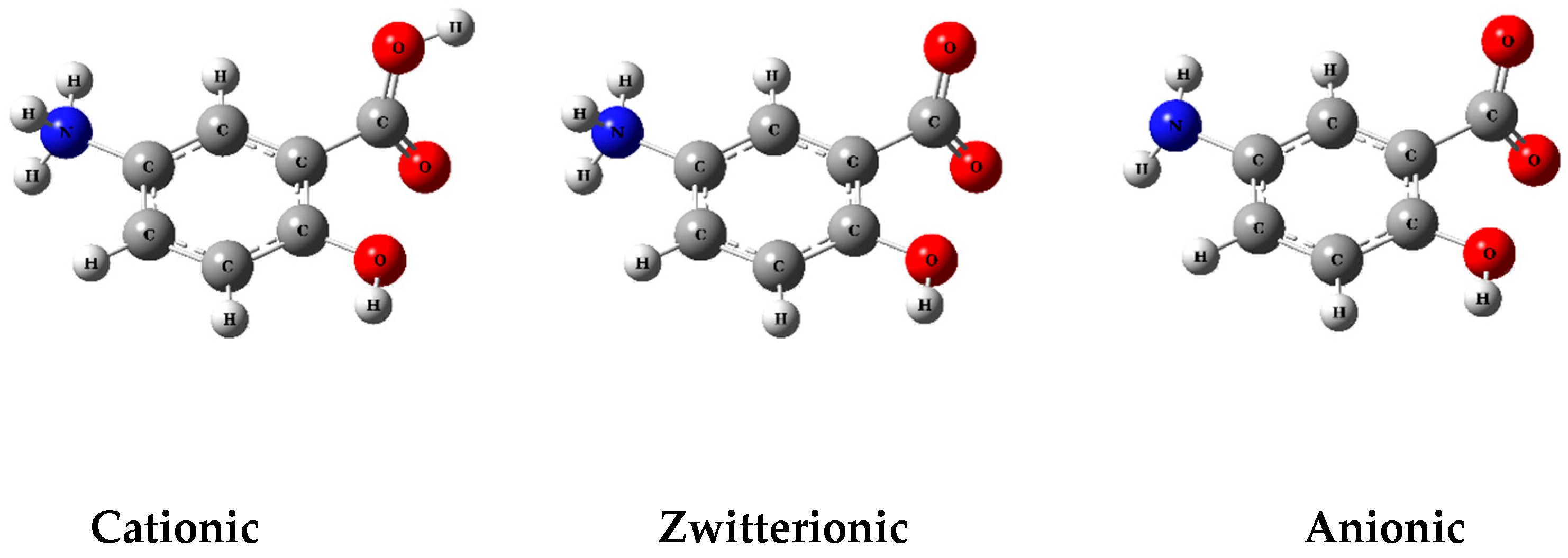
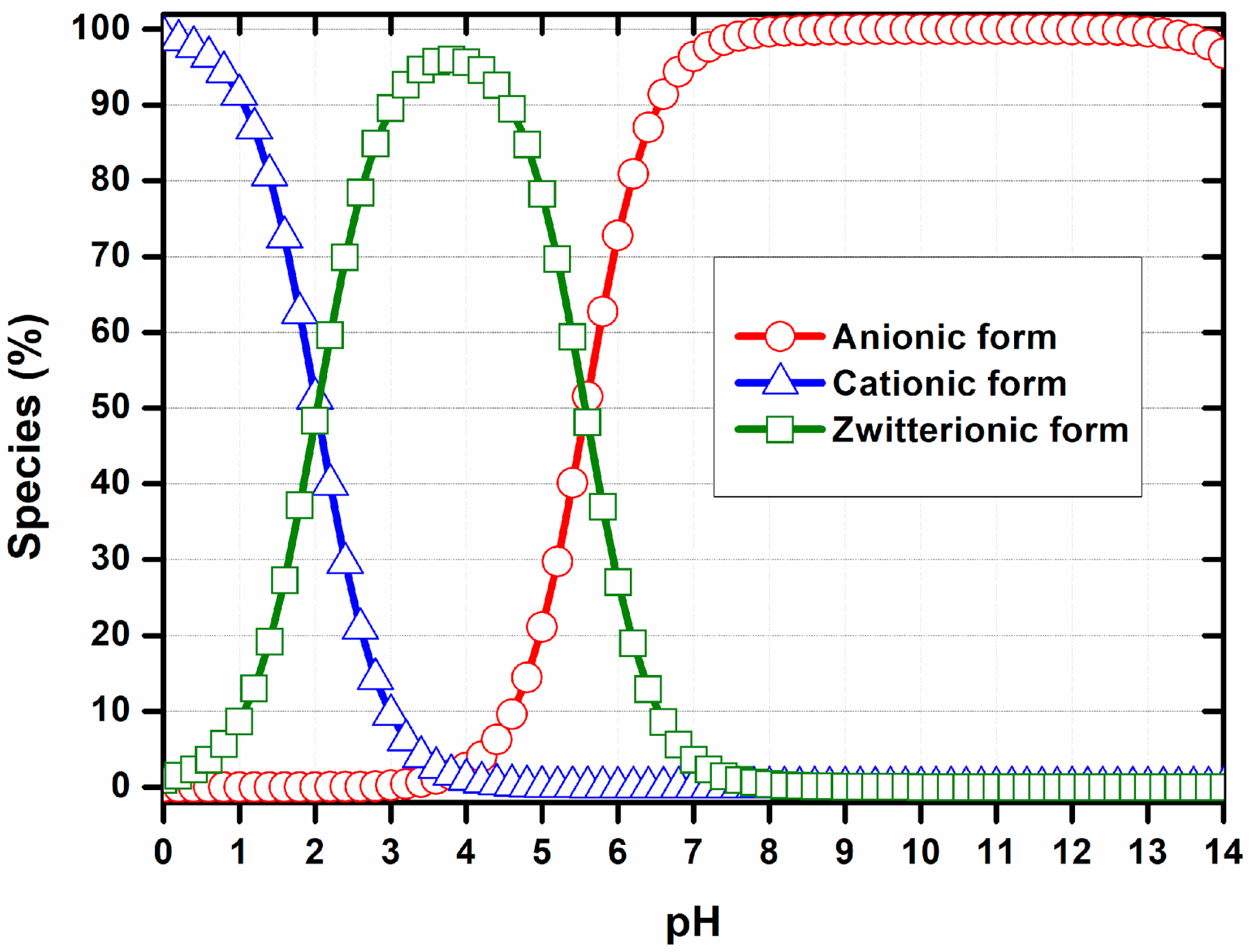
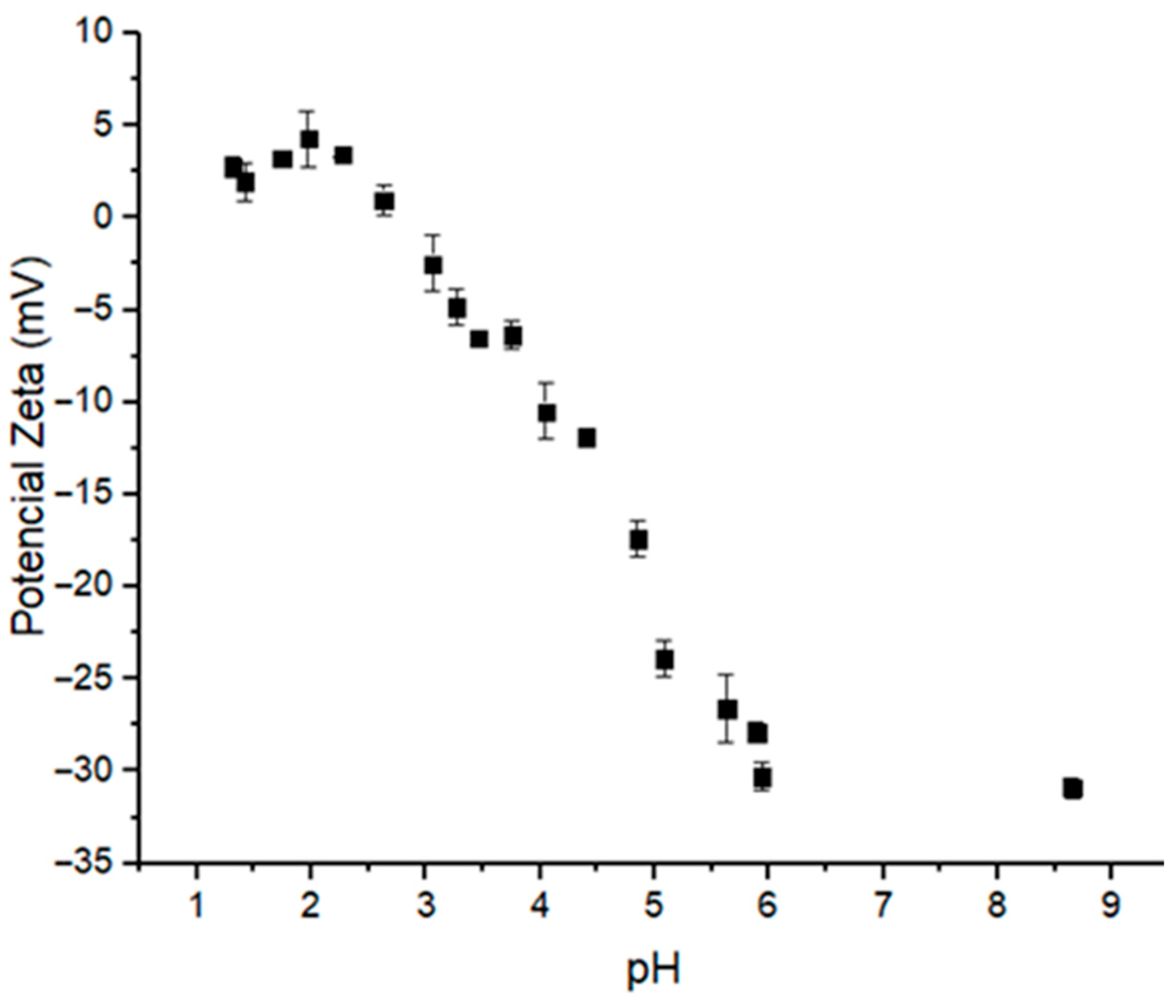


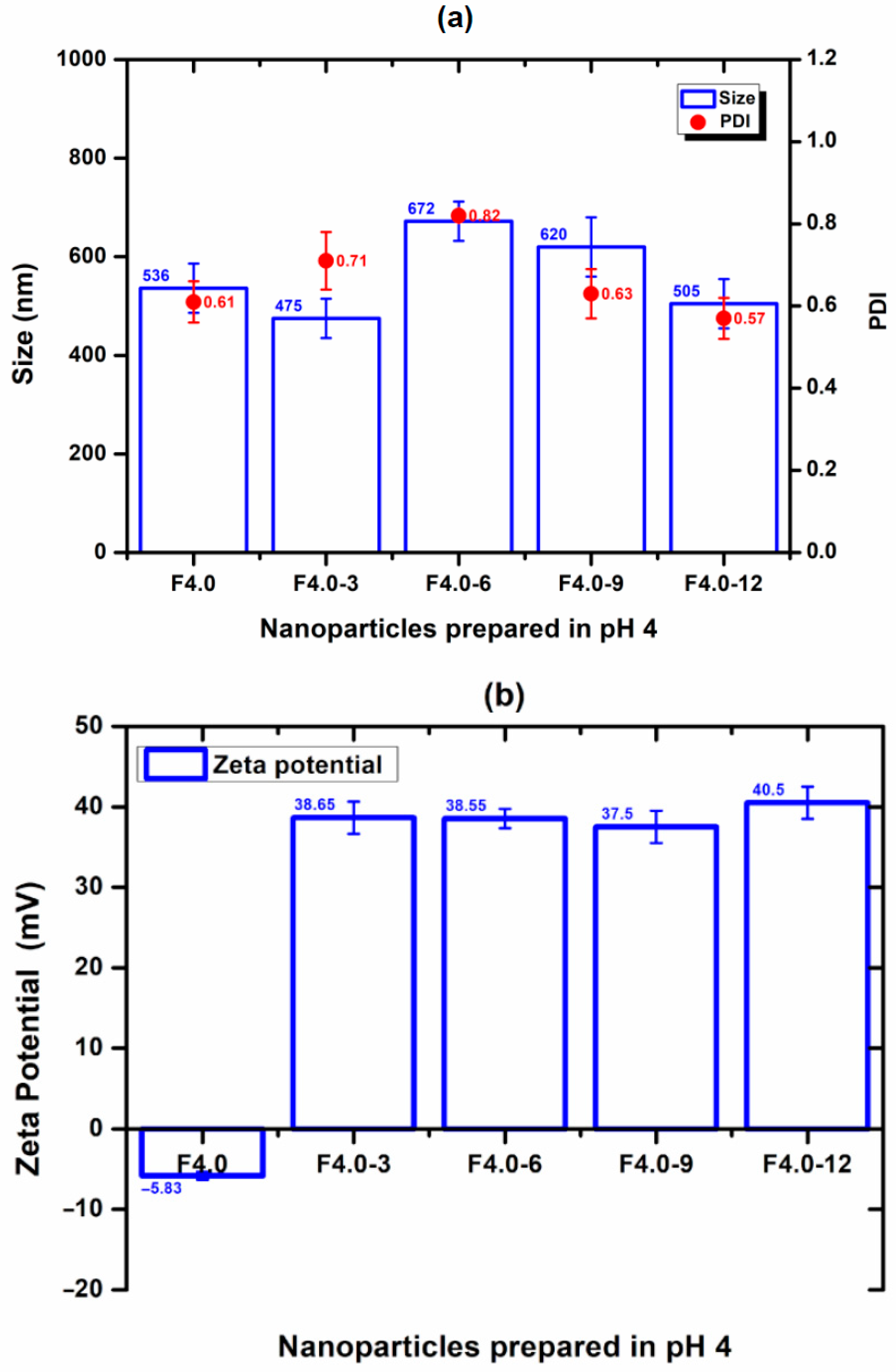

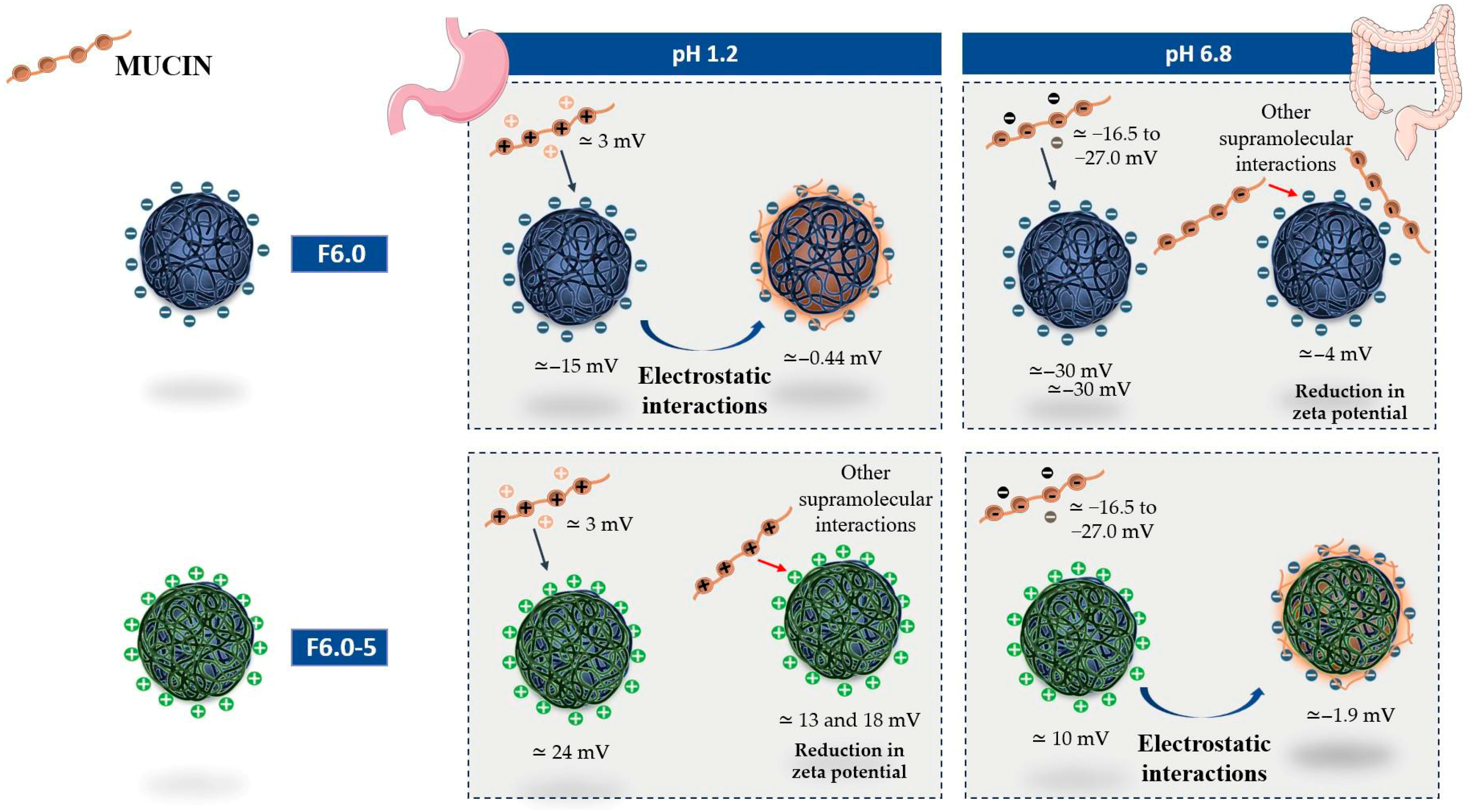
| F1.5 | F4.0 | F6.0 | |
|---|---|---|---|
| MSZ (mg) | 200 | 200 | 200 |
| HCl 0.5 M (mL) | 5 | 5 | 5 |
| H2O (mL) | 10 | 10 | 10 |
| NaOH 1 M (mL) | 1.00 | 2.48 | 3.18 |
| Initial pH | 1.2 | 1.2 | 1.2 |
| Final pH | 1.5 | 4.0 | 6.0 |
| Final MSZ (mg/mL) | 12.5 | 11.44 | 11.00 |
| Number of Mesalazine Molecules | Interaction Energy (kcal·mol−1) | ||
|---|---|---|---|
| Cationic | Zwitterionic | Anionic | |
| 2 | −9.35 | −9.22 | −8.73 |
| 5 | −40.30 | −38.42 | −37.02 |
| 10 | −92.75 | −94.30 | −88.72 |
| 15 | −148.22 | −145.54 | −140.75 |
| 20 | −210.88 | −196.50 | −193.98 |
| 25 | −263.20 | −257.72 | −253.49 |
| 30 | −327.91 | −325.52 | −313.92 |
| MSZ Molecules’ Number | Cluster Volume (A3) | Clusters’ Superficial Area (A2) | ||||
|---|---|---|---|---|---|---|
| Cationic | Zwitterionic | Anionic | Cationic | Zwitterionic | Anionic | |
| 2 | 297.56 | 291.05 | 286.14 | 268.26 | 259.12 | 257.09 |
| 15 | 2456.99 | 2417.00 | 2347.77 | 1404.54 | 1348.82 | 1389.75 |
| 18 | 2963.43 | 2890.42 | 2872.43 | 1667.65 | 1594.71 | 1553.19 |
| 20 | 3300.18 | 3219.04 | 3163.85 | 1850.17 | 1827.18 | 1766.48 |
| 22 | 3654.87 | 3576.35 | 3495.37 | 1995.08 | 1896.45 | 1906.65 |
| 24 | 4002.79 | 3878.67 | 3863.15 | 2191.81 | 2121.81 | 2027.50 |
| 28 | 4659.50 | 4559.63 | 4494.84 | 2511.73 | 2427.85 | 2236.77 |
| 30 | 5008.32 | 4889.54 | 4816.85 | 2666.82 | 2463.60 | 2457.61 |
| pH | Size (nm) | PDI | Zeta Potential (mV) | MSZ Precipitated (%) |
|---|---|---|---|---|
| 1.5 | 936.7 ± 20.2 | 0.588 ± 0.50 | +8.5 ± 0.2 | 51.6 ± 5.5 |
| 4.0 | 556.2 ± 10.4 | 0.478 ± 0.60 | −22.3 ± 1.4 | 95.1 ± 2.4 |
| 6.0 | 145.9 ± 41.6 | 0.497 ± 0.22 | −31.6 ± 0.9 | 75.5 ± 2.4 |
| System | Interaction Energy (kcal·mol−1) | |||
|---|---|---|---|---|
| Mesalazine + 10 Water molecules | Cationic | Zwitterionic | Anionic | 50% Zwitterionic/50% Anionic |
| −1046.84 | 8.80 | −6.59 | 4.25 | |
| Samples | Size (nm) | Zeta Potential (mV) |
|---|---|---|
| F4.0 | 442.4 ± 50 | −5.8 ± 0.5 |
| F4.0-3 | 475.3 ± 40 | 38.6 ± 1.2 |
| F4.0-5 | 327.4 ± 5.8 | 24,7 ± 1,7 |
| F6.0 | 264.8 ± 44 | 15.0 ± 1.0 |
| F6.0-6 | 475.0 ± 64 | 34.9 ± 1.0 |
| F6.0-5 | 169.3 ± 9.7 | 31.8 ± 2.0 |
Disclaimer/Publisher’s Note: The statements, opinions and data contained in all publications are solely those of the individual author(s) and contributor(s) and not of MDPI and/or the editor(s). MDPI and/or the editor(s) disclaim responsibility for any injury to people or property resulting from any ideas, methods, instructions or products referred to in the content. |
© 2025 by the authors. Licensee MDPI, Basel, Switzerland. This article is an open access article distributed under the terms and conditions of the Creative Commons Attribution (CC BY) license (https://creativecommons.org/licenses/by/4.0/).
Share and Cite
Robusti, L.M.G.; Boni, F.I.; Ferreira, L.M.B.; Ferreira, N.N.; Teixeira, D.A.; Gremião, M.P.D. Computational Modeling to Guide the Design of Mesalazine Nanoparticles Tailored for the Incorporation of Chitosan. Polymers 2025, 17, 3053. https://doi.org/10.3390/polym17223053
Robusti LMG, Boni FI, Ferreira LMB, Ferreira NN, Teixeira DA, Gremião MPD. Computational Modeling to Guide the Design of Mesalazine Nanoparticles Tailored for the Incorporation of Chitosan. Polymers. 2025; 17(22):3053. https://doi.org/10.3390/polym17223053
Chicago/Turabian StyleRobusti, Leda Maria Gorla, Fernanda Isadora Boni, Leonardo M. B. Ferreira, Natália Noronha Ferreira, Deiver Alessandro Teixeira, and Maria Palmira Daflon Gremião. 2025. "Computational Modeling to Guide the Design of Mesalazine Nanoparticles Tailored for the Incorporation of Chitosan" Polymers 17, no. 22: 3053. https://doi.org/10.3390/polym17223053
APA StyleRobusti, L. M. G., Boni, F. I., Ferreira, L. M. B., Ferreira, N. N., Teixeira, D. A., & Gremião, M. P. D. (2025). Computational Modeling to Guide the Design of Mesalazine Nanoparticles Tailored for the Incorporation of Chitosan. Polymers, 17(22), 3053. https://doi.org/10.3390/polym17223053









